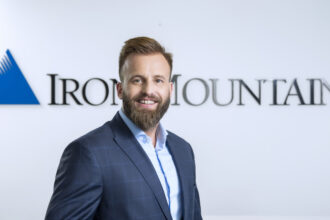Digital transformation is a new priority for many organisations. However, the pace of technological change and, at the same time, the complexity of today’s hybrid environments are such that harnessing the opportunities available and aligning them with business strategy is a major challenge. The support of experts equipped with proven methods and tools allows you to lead the transformation quickly yet securely. We talk about the biggest challenges of digitalisation and IT transformation and the WOW effect with Maciej Toroszewski and Krzysztof Chibowski from the Advisory & Professional Services department at Hewlett Packard Enterprise (HPE) Poland.
What is the genesis of the Advisory & Professional Services department at HPE?
Krzysztof Chibowski : Companies deciding to take on the serious challenge of digitisation lack both competence and tools. HPE recognised this a long time ago and therefore acquired Cloud Technology Partners in 2018. In doing so, we acquired both. These competences were built on the basis of successfully running public cloud migration projects over a period of 10 years. These were the beginnings of the Advisory & Professional Services department in its current form. Today, we have a significant number of experts, methods and tools at our disposal to speed up the implementation of such projects, prevent common mistakes and ensure final success. As an organisation, we have nearly a thousand migrations to our credit. These practices have been developed over many years of experience, are used when supporting new customers and are updated with each successive project. This allows us to offer a repeatable process, rather than improvisation or starting from scratch each time.
Maciej Toroszewski : What is one of the biggest challenges for many companies today? As they want to drive digital transformation and migrate to the public cloud, they clash with issues of data sovereignty, regulatory compliance, cost management or resource consumption itself. After a period of fascination, they begin to see that, in most cases, it is not possible to easily move infrastructure from their own data centre to the public cloud. It turns out that top-notch specialists with vast experience in local data centre issues cannot transfer them to the cloud. The differences are too great. This is why people are the foundation of a successful transformation. So in addition to tools and hard skills, change management becomes critical: organisational and operational. And here, too, we offer our customers proven methods for transitioning from a traditional IT management model to one that fully exploits the capabilities of new technologies. At HPE, we call this model the Edge 2 Cloud Adoption Framework (E2CAF) and it is a complete offering that supports all stages of the transformation to the cloud. Still close to the technology, we are after all a technology company, but based on a flexible agile approach, in line with the expectations and needs of the business in companies.
So cloud computing is the biggest challenge at the moment?
K.C.: No, it is just one of the challenges. Others include Data Management or reducing CO? emissions. This is embedded in both IT department strategies and overall business plans. The traditional way of doing projects was to secure the complete infrastructure within a certain timeframe. Therefore, customers bought all the equipment at the beginning of the project. Only part of it worked in production, with the rest acting as a buffer to allow for operations in the event of an increase in power or capacity requirements. The whole had to be not only powered, but also kept in the right conditions, including the right temperature. All of this significantly increases energy consumption relative to actual, current needs, and in the context of the aforementioned reduction of CO? emissions, optimisation in this area is very much needed. For example, investments in Data Centre cooling equipment made 10 years ago can now be replaced by more efficient and economical equipment. The result? Savings of up to 70-80 per cent. In the case of old-generation servers, the situation is similar.
So customers today expect more from a technology supplier than the product itself….
K.C.: Yes, definitely yes. The hardware platform is slowly disappearing from the centre of attention. Containerised solutions, such as HPE Ezmeral, for example, make us able to use the infrastructure we have more efficiently. Few companies today buy only hardware. On their own, they find it difficult to find their way through the maze of new technologies and services. Some lack the time, others lack the competence or experience. This is why most opt for solutions and technology they already know. Some need a partner with whom they can discuss everything in detail and who can show them the full spectrum of available options. Invariably, they all want results – fast, spectacular, cost-effective, making the most of what they already have.
HPE Advisory & Professional Services is a high-level consultancy offering, but with direct reference to specific technologies. At the moment, the main driver of change is data – its growth and the information it brings with it, but that’s a topic for a longer conversation. The bottom line is that we are able to guide the client from the very beginning to the end of their transformation.
M.T.: One of our differentiators is proactivity. We analyse publicly available company strategies and prepare concrete solution proposals for clients. We suggest how business objectives can be achieved on the basis of existing technologies, advise on the order of projects comprising the transformation, which projects are worth undertaking and which should be omitted – due to risk, cost or scale of difficulty. There is no cost to the client for such a meeting. This is a major change in the approach to IT solution discussions because, as a technology provider, we want to make sure that we are delivering an optimal solution that supports the strategic and business goals of the service recipient within the customer’s organisation.
What can customers expect from APS services?
M.T.: Take the Digital Next Advisory service, which is about creating a detailed transformation map. This is based on a framework developed over years and hundreds of projects around the world that makes it easy to link IT projects to business objectives. We show precisely what, when and how to implement. We sometimes joke that we walk into a client and generate a WOW effect. However, there is something in that. We show clients new possibilities, opportunities and threats, pitfalls they hadn’t thought of before, and they gain a whole new perspective as a result. This clarifies for them what they want and what they can achieve, and at the same time what they need to do so.
K.C.: It’s worth mentioning that APS’s services combine perfectly with HPE’s GreenLake offering, which makes it easier for customers to achieve their goals without having to move applications and data to the public cloud. Whatever the reason they don’t want to or can’t do that, we can offer them a cloud experience in their own data centre. This is hugely important in an organisation-wide digital transformation. It does not always make sense to move all a customer’s systems to the cloud. There is quite a strong current trend of going back to on-prem solutions and creating private cloud solutions. It turns out that it is best anywhere, but best in one’s own data centre.
M.T.: Finally, I would like to add that our services are independent of specific technologies or cloud service providers – we always recommend to our customers what is optimal for them in their specific situation.







